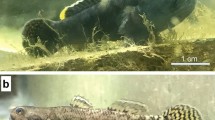Abstract
Spawning was induced between April and July, 1972, in the West Indian ophiuroid Ophiolepis elegans (Lütken) by a combined temperature and light-shock method. The large (0.25 mm) yolky eggs develop into vitellaria larvae with 4 ciliated bands. The larvae complete metamorphosis within 3 days. Up to 75% of the ophiuroid and echinoid species found in the euryhaline estuary at Cedar Key, Florida (USA), may have some developmental modification which reduces larval exposure to the pelagic environment. Such a high percentage of species with modified development in a subtropical area suggests a selective advantage to these species in areas of salinity variability. Egg counts of two species with vitellaria larvae indicate that egg numbers vary with disk size and are roughly intermediate to counts for species with direct or planktotrophic development.
Similar content being viewed by others
Literature cited
Bierman, J.A.: Echinoderm larvae of Beaufort, North Carolina, 50 pp. Master's thesis, Duke University 1943.
Binyon, J.: Salinity tolerance and ionic regulation. In: Physiology of Echinodermata, pp 359–378. Ed. by R. A. Boolootian. New York: Interscience Publishers 1966.
Brooks, W. K. and C. Grave: Ophiura brevispina. Mem. natn. Acad. Sci. 8, 79–100 (1899).
Caldwell, J. W.: Development, metamorphosis, and substrate selection of the larvae of the sand dollar, Mellita quinquesperforata (Leske, 1778), 64 pp. Master's thesis, University of Florida 1972.
Clark, H. L.: The distribution of the littoral echinoderms of the West Indies. Publs Carnegie Instn 281, 49–75 (1919).
D'Asaro, C. N.: Some aspects of the development of Clypeaster rosaceus. (Abstr.). Q. Jl Fla Acad. Sci. 35 (1) Suppl., p. 8 (1972).
Dan, K.: Echinoderma. In: Invertebrate embryology, pp 280–315. Ed. by M. Kumé and K. Dan. National Technical Information Service Document TT-67-58050, Washington, D. C.: U.S. Dept. of Commerce 1968.
Fenaux, L.: Le developpement larvaire chez Ophioderma longicauda (Retzius). Cah. Biol. mar. 10, 59–62 (1969).
—: Evolution saisonnière des gonades chez l'ophiure Ophioderma longicauda (Retzius), Ophiuroidea. Int. Revue ges. Hydrobiol. 57, 257–262 (1972).
Harvey, E. B.: The American Arbacia and other sea urchins, 298 pp. New Jersey: Princeton University Press 1956.
Hyman, L. H.: The invertebrates. Vol. IV. Echinodermata. The coelomate bilateria, 763 pp. New York: McGraw-Hill 1955.
Kinne, O.: The effects of temperature and salinity on marine and brackishwater animals. II. Salinity and temperature-salinity combinations. Oceanogr. mar. Biol. A. Rev. 2, 281–340 (1964).
Madsen, F. J.: West African ophiuroids. Atlantide Rep. 11, 151–243. Copenhagen: Danish Science Press, Ltd. 1970.
Mileikovsky, S. A.: Types of larval development in marine bottom invertebrates, their distribution and ecological significance: a re-evaluation. Mar. Biol. 10, 193–213 (1971).
Mortenson, Th.: On hermaphroditism in viviparous ophiuroids. Acta zool., Stock. 1, 1–19 (1920).
—: Studies on the development and larval forms of echinoderms, 261 pp. Copenhagen: G. E. C. Gad 1921.
—: Contributions to the study of the development and larval forms of echinoderms. K. danske Vidensk. Selsk. Skr. 7, 1–59 (1938).
Schoener, A.: Fecundity and possible mode of development of some deep-sea ophiuroids. Limnol. Oceanogr. 17, 193–199 (1972).
Stancyk, S. E.: Studies on the biology and ecology of ophiuroids at Cedar Key, Florida, 92 pp. Master's thesis, University of Florida 1970.
Thomas, L. P.: Distribution and salinity tolerance of the amphiurid brittlestar, Ophiophragmus filograneus (Lyman 1875). Bull. mar. Sci. Gulf Caribb. 11, 158–160 (1961).
—: The shallow-water amphiurid brittle stars (Echinodermata, Ophiuroidea) of Florida. Bull. mar. Sci. Gulf Caribb. 12, 623–694 (1962).
Thorson, G.: Larval development, growth and metabolism of Arctic marine bottom invertebrates compared with those of other seas. Meddr Grønland 100, 1–155 (1936).
—: Reproduction and larval development of Danish marine bottom invertebrates. Meddr Kommn Havunders. (Serie Plankton) 4, 1–523 (1946).
—: Reproductive and larval ecology of marine bottom invertebrates. Biol. Rev. 25, 1–45 (1950).
—: Some factors influencing the recruitment and establishment of marine benthic communities. Neth. J. Sea Res. 3, 267–293 (1966).
Author information
Authors and Affiliations
Additional information
Communicated by J. Bunt, Miami
Rights and permissions
About this article
Cite this article
Stancyk, S.E. Development of Ophiolepis elegans (Echinodermata: Ophiuroidea) and its implications in the estuarine environment. Marine Biology 21, 7–12 (1973). https://doi.org/10.1007/BF00351186
Accepted:
Issue Date:
DOI: https://doi.org/10.1007/BF00351186




